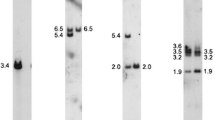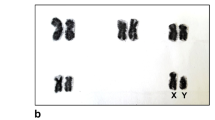Abstract
Like the unique platypus itself, the platypus genome is extraordinary because of its complex sex chromosome system, and is controversial because of difficulties in identification of small autosomes and sex chromosomes. A 6-fold shotgun sequence of the platypus genome is now available and is being assembled with the help of physical mapping. It is therefore essential to characterize the chromosomes and resolve the ambiguities and inconsistencies in identifying autosomes and sex chromosomes. We have used chromosome paints and DAPI banding to identify and classify pairs of autosomes and sex chromosomes. We have established an agreed nomenclature and identified anchor BAC clones for each chromosome that will ensure unambiguous gene localizations.
Similar content being viewed by others
References
Alsop AE, Miethke P, Rofe R et al. (2005) Characterizing the chromosomes of the Australian model marsupial Macropus eugenii (tammar wallaby). Chromosome Res 13: 627–36.
Bick YAE (1992) The meiotic chain of chromosomes of Monotremata. In: Augee M., ed. Platypus and Echidnas. Sydney: Royal Society of New South Wales, pp. 63–68.
Bick YAE, Jackson WD (1967) A mammalian X-O sex chromosome system in the monotreme Tachyglossus aculeatus determined from leucocyte cultures and testicular preparations. Amer Nat 101: 79–6.
Bick YAE, Sharman GB (1975) The chromosomes of the platypus (Ornithorhynchus: Monotremata). Cytobios 14: 17–8.
Bick YAE, Murtagh C, Sharman GB (1973) The chromosomes of an egg-laying mammal Tachyglossus aculeatus (the echidna). Cytobios 7: 233–43.
Bininda-Emonds OR, Cardillo M, Jones KE et al. (2007) The delayed rise of present-day mammals. Nature 446: 507–12.
Cooper D, Johnston PG, Graves JAM, Watson JM (1993) X-inactivation in marsupials and monotremes. Semin Dev Biol 4: 117–28.
Dohm JC, Tsend-Ayush E, Reinhart R, Grutzner F, Himmelbauer H (2007) Disruption and pseudoautosomal localization of the Major Histocompatibility Complex in monotremes. Genome Biol 8: R175.
Edwards CA, Rens W, Clark O et al. (2007) The evolution of imprinting: chromosomal mapping of orthologues of mammalian imprinted domains in monotreme and marsupial mammals. BMC Evol Biol 7: 157, doi 10.1186/1471-2148-7-157.
El-Mogharbel N, Wakefield MJ, Deakin JE et al. (2007) DMRT gene cluster analysis in the platypus: new insights into genomic organization and regulatory regions. Genomics 89: 10–1.
Grafodatskaya D, Rens R, Wallis MC, Trifonov V, O'Brien PCM, Clarke O, Graves JAM, Ferguson-Smith MAF (2007) Search for sex-determining switch in monotremes: mapping WT1, SF1, LHX1, LHX2, FGF9, WNT4, RSPO1 and GATA4 in platypus. Chromosom Res 15: 777–85.
Graves JAM (2006) Sex chromosome dynamics and Y chromosome degeneration. Cell 124: 901–14.
Griffiths M (1978) The Biology of the Monotremes. London: Academic Press.
Grützner F, Graves JAM (2004) A platypus' eye view of the mammalian genome. Current Opinions in Genetics and Development 14: 642–49.
Grützner F, Rens W, Tsend-Ayush E et al. (2004). In the platypus a meiotic chain of ten sex chromosomes shares genes with the bird Z and mammal X chromosomes. Nature 432: 913–17.
Grützner F, Rens, Watson JM, Ferguson-Smith MA, Graves JAM (2006). The chromosomes of monotreme mammals. In: O’Brien SJ, Menninger J, Nash WG, eds. Mammalian Chromosome Atlas. New York: Wiley-Liss, pp. 1–8.
Kirby PJ, Waters PD, Delbridge ML et al. (2002) Cloning and mapping of platypus SOX2 and SOX14 — insights into SOX group B evolution. Cytogenet Genome Res 98: 96–00.
Margulies EH, Maduro VV, Thomas PJ et al. (2005) Comparative sequencing provides insights about the structure and conservation of marsupial and monotreme genomes. Proc Natl Acad Sci USA 102: 3354–359.
Matthey R (1949) Les chromosomes des vertebrées. Lucerne: F. Rouge.
Murtagh C (1977) A unique cytogenetics system in monotremes. Chromosoma 65: 37–7.
Rapkins RW, Hore T, Smithwick M et al. (2006) Recent assembly and initiating of imprinting in the Prader–Willi/Angelman imprinted domain. PLOS Genet 2: e182.
Rens W, Grützner F, O’Brien PCM, Fairclough H, Graves JAM, Ferguson-Smith MA (2004) Resolution and evolution of the duck-billed platypus karyotype with an X1Y1 X2Y2 X3Y3 X4Y4 X5Y5 male sex chromosome constitution. Proc Natl Acad Sci USA 101: 16257–6261.
Rens W, O’Brien PCM, Grützner F, Clarke O, Graphodatskaya D, Tsend-Ayush E, Trifonov VA, Skelton H, Wallis MC, Johnson S, Veyrunes F, Graves JAM, Ferguson-Smith MA (2007) The multiple sex chromosomes of platypus and echidna are not completely identical and several share homology with the avian Z. Genome Biol 8: R243.
Seabright M (1971) A rapid banding technique for human chromosomes. Lancet 2: 971–72.
Telenius H, Pelmear AH, Tunnacliffe A et al. (1992) Cytogenetic analysis by chromosome painting using DOP-PCR amplified flow-sorted chromosomes. Genes Chromosomes Cancer 4: 257–63.
VanBrink J (1959) L’expression morphologique de la diagametie chez les sauropsids et les monotremes. Chromosoma 10: 1–2.
Wakefield MJ, Graves JAM (2005) Marsupials and monotremes sort genome treasures from junk. Genome Biol 6: 218.
Wallis MC, Delbridge ML, Pask AJ et al. (2006) Mapping platypus SOX genes; autosomal location of SOX9 excludes it from sex determining role. Cytogenet Genome Res 116: 232–34.
Warren WC, Hillier LW, Graves JAM et al. (2008) Genome analysis of the platypus distinguishes derived mammalian from ancestral reptilian features. Nature (in press).
Waters PD, Delbridge ML, Deakin J et al. (2005) Autosomal location of genes from the conserved mammalian X in the platypus (Ornithorhynchus anatinus): implications for mammalian sex chromosome evolution. Chromosome Res 13: 401–10.
Watson JM, Spencer JA, Riggs AD, Graves JAM (1990) The X chromosome of monotremes shares a highly conserved region with the eutherian and marsupial X chromosomes, despite the absence of X chromosome inactivation. Proc Natl Acad Sci USA 87: 7125–129.
Watson JM, Meyne J, Graves JAM (1992) Studies of the chromosomes of the echidna meiotic translocation chain. In: Augee M., ed. Platypus and Echidnas. Sydney: Royal Society of New South Wales, pp. 53–63.
Wrigley JM, Graves JAM (1984) Two monotreme cell lines derived from female platypuses. (Ornithorhynchus anatinus; Monotremata, Mammalia). In Vitro 20: 321–28.
Wrigley JM, Graves JAM (1988a) Karyotypic conservation in the mammalian Order Monotremata (subclass Prototheria). Chromosoma 96: 231–47.
Wrigley JM, Graves JAM (1988b) Sex chromosome homology and incomplete, tissue-specific inactivation suggest that monotremes represent an intermediate stage of mammalian sex chromosome evolution. J Hered 79: 115–18.
Author information
Authors and Affiliations
Corresponding author
Additional information
Daniel McMillan, Pat Miethke and Amber E. Alsop contributed equally to the work.
Rights and permissions
About this article
Cite this article
McMillan, D., Miethke, P., Alsop, A.E. et al. Characterizing the chromosomes of the platypus (Ornithorhynchus anatinus). Chromosome Res 15, 961–974 (2007). https://doi.org/10.1007/s10577-007-1186-2
Received:
Revised:
Accepted:
Published:
Issue Date:
DOI: https://doi.org/10.1007/s10577-007-1186-2




